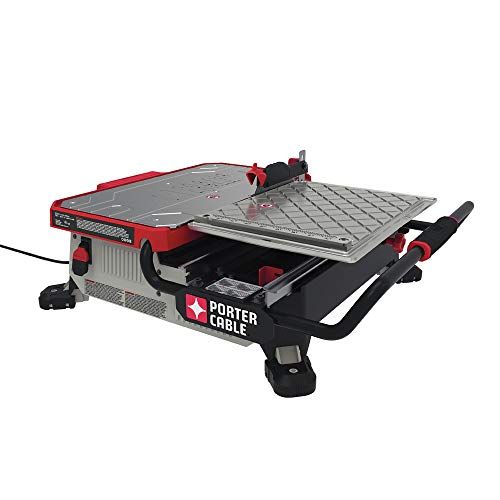PORTER-CABLE Wet Tile Saw
Factors to Consider Before Purchasing

When it comes to purchasing a wet tile saw, there are several factors that users should consider to ensure they make the right choice for their needs. The following are some of the most important factors to consider:
1. Power and Motor: Users should assess the power and motor capacity of the wet tile saw they are interested in. This will determine the speed and efficiency with which the saw cuts through tiles. A more powerful motor will be able to handle tougher tiles and provide quicker and cleaner cuts.
2. Blade Size and Adjustability: The blade size and adjustability are crucial factors to consider. Users should check if the wet tile saw comes with different blade options and if the height and angle of the blade can be adjusted. This will allow for more versatile cutting and the ability to achieve different cutting depths and angles.
3. Cutting Capacity and Fence: It is essential to consider the cutting capacity and the quality of the fence. Users should look for a wet tile saw that can accommodate the size of tiles they typically work with. Additionally, a sturdy and accurate fence will ensure straight and precise cuts, enhancing the overall performance of the saw.
4. Water Source and Management: Wet tile saws require a constant water source to keep the blade cool and lubricated during the cutting process. Users should consider how the saw manages water supply and whether it has a built-in water pump or requires an external source. Additionally, it is beneficial to check if the saw has features to control water splash and minimize mess.
5. Portability and Mobility: Depending on the user's needs, portability and mobility can be crucial factors to consider. If the saw needs to be moved frequently or used in different locations, a lighter and more compact design would be advantageous. Some wet tile saws come with built-in handles or collapsible stands for easy transportation.

Common Questions

Q: Can a wet tile saw be used for materials other than tiles?
A: Yes, wet tile saws can be used for various materials such as natural stone, porcelain, and ceramic. However, it is important to check the specific saw's cutting capacity and blade compatibility to ensure it can handle the material intended for cutting.
Q: How often should I change the blade?
A: The frequency of blade changes depends on the usage and the type of materials being cut. As a general guideline, it is recommended to change the blade when it becomes dull or shows signs of wear. Regularly inspecting the blade and replacing it as necessary will ensure optimal performance and clean cuts.
Q: Can I use a wet tile saw without water?
A: It is strongly advised against using a wet tile saw without water. The water is essential for cooling the blade and reducing friction, preventing overheating and potential damage to the saw and blade. Attempting to use a wet tile saw without water can result in decreased cutting efficiency and a higher risk of blade failure.
Conclusion

In conclusion, when considering purchasing a wet tile saw such as the PORTER-CABLE Wet Tile Saw, it is important to assess factors such as power and motor capacity, blade size and adjustability, cutting capacity and fence quality, water source and management, as well as portability and mobility. By carefully evaluating these key factors and addressing common questions related to wet tile saws, users can make an informed decision that suits their specific needs and ensures efficient and accurate tile cutting.

